 |
 |
Our enthusiastic and extremely knowledgeable perennials team is here to answer your questions and help you choose the best perennials for your situation. There’s always something in bloom for sun, shade, butterflies, birds or deer resistance as well as a variety of bulbs for your space.
Stroll through our time-tested favorites and introduce yourself to the newest varieties. We garden with perennials too; we love them and it shows!
|
30 found, showing page 2 of 2

Heat and humidity tolerant, mounding habit, and periwinkle blue blooms appearing late spring. Near-Black Stems. USDA 4-9
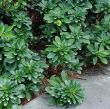
Green leaves in rosettes. Evergreen groundcover. USDA 6-8
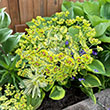
Lime blooms. Evergreen multicolored foliage. Compact. USDA 5-9
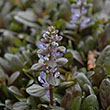
Naturalizing groundcover with short spikes of blue flowers on chocolate-colored foliage with burgundy highlights. USDA 3-9.
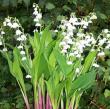
Plants form a spreading clump of large green leaves, bearing short spikes of fragrant white bells in late spring. Takes a year or two to establish, then spreads quickly. USDA 3-8
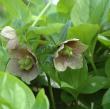
Lenten Rose | White to rose-purple blooms. Mounding. Evergreen USDA 4-9
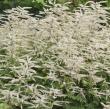
Fern-like dark foliage on red stems. White flowers from late spring to eary summer. Compact. USDA 4-7
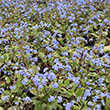
Distinctive silvery white leaves with a thin green rim around the leaf edges. Small, forget-me-not-like flowers of light blue with yellow centers. USDA 2-8
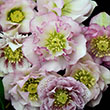
Height: 24 inches
Spacing: 18 inches
Sunlight: partial shade, full shade
Hardiness Zone: 4a
Other Names: Lenten Rose, Winter Rose
Group/Class: Wedding Party Series
Brand: Walters Gardens
Description:
An easy to grow selection producing romantic double blooms in shades of light pink; blooms emerge in late winter and early spring above attractive green foliage; ideal for shade gardens; great as cut flowers or in borders and beds
Ornamental Features:
Wedding Party Flower Girl Hellebore features showy nodding shell pink cup-shaped flowers with pink overtones at the ends of the stems from late winter to early spring. Its glossy pointy compound leaves remain green in color throughout the year.
Landscape Attributes:
Wedding Party Flower Girl Hellebore is an herbaceous evergreen perennial with an upright spreading habit of growth. Its medium texture blends into the garden, but can always be balanced by a couple of finer or coarser plants for an effective composition.
This is a relatively low maintenance plant, and should be cut back in late fall in preparation for winter. Deer don't particularly care for this plant and will usually leave it alone in favor of tastier treats. It has no significant negative characteristics.
Wedding Party Flower Girl Hellebore is recommended for the following landscape applications:
- Mass Planting
- Rock/Alpine Gardens
- Border Edging
- General Garden Use
- Naturalizing And Woodland Gardens
Planting & Growing:
Wedding Party Flower Girl Hellebore will grow to be about 20 inches tall at maturity, with a spread of 24 inches. When grown in masses or used as a bedding plant, individual plants should be spaced approximately 18 inches apart. Its foliage tends to remain dense right to the ground, not requiring facer plants in front. It grows at a medium rate, and under ideal conditions can be expected to live for approximately 5 years. As an evegreen perennial, this plant will typically keep its form and foliage year-round.
This plant does best in partial shade to shade. It does best in average to evenly moist conditions, but will not tolerate standing water. This plant should not require much in the way of fertilizing once established, although it may appreciate a shot of general-purpose fertilizer from time to time early in the growing season. It is not particular as to soil pH, but grows best in rich soils. It is somewhat tolerant of urban pollution, and will benefit from being planted in a relatively sheltered location. This particular variety is an interspecific hybrid, and parts of it are known to be toxic to humans and animals, so care should be exercised in planting it around children and pets. It can be propagated by division; however, as a cultivated variety, be aware that it may be subject to certain restrictions or prohibitions on propagation.
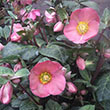
Penny's Pink' Hellebore | Muave outward-facing blooms. Marbled evergreen foliage. USDA 4-9

Height: 22 inches
Spacing: 18 inches
Sunlight: partial shade, full shade
Hardiness Zone: 4a
Other Names: Lenten Rose, Winter Rose
Group/Class: Honeymoon Series
Brand: Proven Winners
Description:
This attractive variety produces bushy mounds of thick evergreen leaves; flower stalks bear showy, cup shaped blooms in shades of pink with purple edges; a great selection for shade gardens
Ornamental Features:
Honeymoon Paris In Pink Hellebore features showy nodding pink cup-shaped flowers with purple edges at the ends of the stems from late winter to early spring. Its attractive serrated oval compound leaves remain dark green in color throughout the year.
Landscape Attributes:
Honeymoon Paris In Pink Hellebore is an herbaceous evergreen perennial with an upright spreading habit of growth. Its medium texture blends into the garden, but can always be balanced by a couple of finer or coarser plants for an effective composition.
This is a relatively low maintenance plant, and should be cut back in late fall in preparation for winter. Deer don't particularly care for this plant and will usually leave it alone in favor of tastier treats. It has no significant negative characteristics.
Honeymoon Paris In Pink Hellebore is recommended for the following landscape applications:
- Mass Planting
- Rock/Alpine Gardens
- Border Edging
- General Garden Use
- Naturalizing And Woodland Gardens
Planting & Growing:
Honeymoon Paris In Pink Hellebore will grow to be about 18 inches tall at maturity, with a spread of 24 inches. When grown in masses or used as a bedding plant, individual plants should be spaced approximately 18 inches apart. Its foliage tends to remain dense right to the ground, not requiring facer plants in front. It grows at a medium rate, and under ideal conditions can be expected to live for approximately 5 years. As an evegreen perennial, this plant will typically keep its form and foliage year-round.
This plant does best in partial shade to shade. It does best in average to evenly moist conditions, but will not tolerate standing water. It is not particular as to soil pH, but grows best in rich soils. It is somewhat tolerant of urban pollution, and will benefit from being planted in a relatively sheltered location. This particular variety is an interspecific hybrid, and parts of it are known to be toxic to humans and animals, so care should be exercised in planting it around children and pets. It can be propagated by division; however, as a cultivated variety, be aware that it may be subject to certain restrictions or prohibitions on propagation.
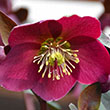
'Anna's Red' Hellebore | Burgundy outward facing blooms. Marbled foliage. Evergreen. USDA 4-9

Pale yellow single blooms with deep red centers. Evergreen. USDA 4-9
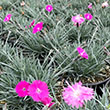
Fragrant pink blooms. Tufted, Mounded habit. USDA: 3-8
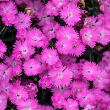
Plant Height: 6 inches
Flower Height: 8 inches
Spacing: 8 inches
Sunlight: full sun
Hardiness Zone: 3a
Other Names: Cheddar Pinks, Clove Pinks
Description:
A robust variety bearing single, fuchsia flowers in late spring to early summer, over a cushion of blue-green, grass-like leaves; has a mild, clove-like, spicy fragrance; will sporadically re-bloom throughout the summer
Ornamental Features:
Firewitch Pinks has masses of beautiful fragrant fuchsia frilly flowers with white eyes at the ends of the stems from late spring to mid summer, which are most effective when planted in groupings. The flowers are excellent for cutting. Its attractive grassy leaves remain silvery blue in color throughout the year.
Landscape Attributes:
Firewitch Pinks is an herbaceous evergreen perennial with a mounded form. It brings an extremely fine and delicate texture to the garden composition and should be used to full effect.
This plant will require occasional maintenance and upkeep, and is best cleaned up in early spring before it resumes active growth for the season. It is a good choice for attracting bees and butterflies to your yard, but is not particularly attractive to deer who tend to leave it alone in favor of tastier treats. It has no significant negative characteristics.
Firewitch Pinks is recommended for the following landscape applications:
- Mass Planting
- Rock/Alpine Gardens
- Border Edging
- General Garden Use
- Container Planting
- Planting & Growing
Firewitch Pinks will grow to be only 6 inches tall at maturity extending to 8 inches tall with the flowers, with a spread of 10 inches. When grown in masses or used as a bedding plant, individual plants should be spaced approximately 8 inches apart. Its foliage tends to remain low and dense right to the ground. It grows at a medium rate, and under ideal conditions can be expected to live for approximately 5 years. As an evegreen perennial, this plant will typically keep its form and foliage year-round.
This plant should only be grown in full sunlight. It prefers to grow in average to moist conditions, and shouldn't be allowed to dry out. It is not particular as to soil type or pH. It is highly tolerant of urban pollution and will even thrive in inner city environments. This is a selected variety of a species not originally from North America. It can be propagated by cuttings; however, as a cultivated variety, be aware that it may be subject to certain restrictions or prohibitions on propagation.
Firewitch Pinks is a fine choice for the garden, but it is also a good selection for planting in outdoor pots and containers. It is often used as a 'filler' in the 'spiller-thriller-filler' container combination, providing a mass of flowers and foliage against which the thriller plants stand out. Note that when growing plants in outdoor containers and baskets, they may require more frequent waterings than they would in the yard or garden.
30 found, showing page 2 of 2











